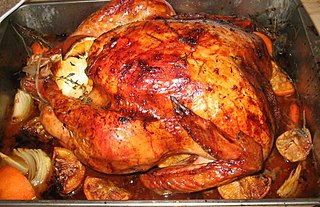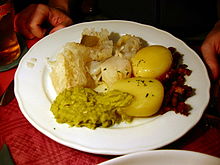
Swedish cuisine is the traditional food of Sweden. Due to Sweden's large north-to-south expanse, there are regional differences between the cuisine of North and South Sweden.

Lutefisk is dried whitefish, usually cod, but sometimes ling or burbot, cured in lye. It is made from aged stockfish, or dried and salted cod. The fish takes a gelatinous texture after being rehydrated for days prior to eating.

Head cheese or brawn is a cold cut terrine or meat jelly that originated in Europe. It is made with flesh from the head of a calf or pig, typically set in aspic, and usually eaten cold, at room temperature, or in a sandwich. Despite its name the dish is not a cheese and contains no dairy products. The parts of the head used vary, and may include the tongue and sometimes the feet and heart but do not commonly include the brain, eyes or ears. Trimmings from more commonly eaten cuts of pork and veal are often used, with gelatin added as a binder.

Mulled wine, also known as spiced wine, is an alcoholic drink usually made with red wine, along with various mulling spices and sometimes raisins, served hot or warm. It is a traditional drink during winter, especially around Christmas. It is usually served at Christmas markets in Europe, primarily in Germany, Austria, Switzerland, Nordics and eastern France. There are non-alcoholic versions of it. Vodka-spiked mulled wine can be found in Polish Christmas markets, where mulled wine is commonly used as a mixer.

Akvavit or aquavit is a distilled spirit that is principally produced in Scandinavia, where it has been produced since the 15th century. Akvavit is distilled from grain or potatoes, and is flavoured with a variety of herbs. It is also popular in Northern Germany.

A semla, vastlakukkel, laskiaispulla, Swedish eclair, fastlagsbulle/fastelavnsbolle or vēja kūkas is a traditional sweet roll made in various forms in Sweden, Finland, Norway, Denmark, the Faroe Islands, Iceland, Estonia, and Latvia, associated with Lent and especially Shrove Tuesday in most countries, Shrove Monday in Denmark, parts of southern Sweden, Iceland and Faroe Islands or Sunday of Fastelavn in Norway. In Sweden it is most commonly known as just semla, but is also known as fettisdagsbulle, lit. 'Fat Tuesday bun' or 'Shrove Tuesday bun'. In the southern parts of Sweden, as well as in Swedish-speaking Finland, it is known as fastlagsbulle. In Poland it is known as ptyś. In Estonia it is called vastlakukkel. In Norway and Denmark it is called fastelavnsbolle. In Iceland, it is known as a bolla and served on Bolludagur. In Faroe Islands it is called Føstulávintsbolli, and is served on Føstulávintsmánadagur. In Latvia, it is called vēja kūkas. Semla served in a bowl of hot milk is hetvägg.

Snaps is a Danish and Swedish word for a small shot of a strong alcoholic beverage taken during the course of a meal. A ritual that is associated with drinking snaps is a tradition in Scandinavia, especially in Denmark and Sweden, where it is very common to drink snaps at holidays such as Midsummer, Christmas and Easter. This ritual has been described by one author as follows:
A group of people are clustered around a table for a typical lunch that will include several courses and a clear, fiery drink. The host pours the ice-cold liquid into frosty, conical glasses with long stems. He raises his glass, at which point the diners turn to one another and make eye contact, making certain not to leave anyone out. "Skål!" calls out the host, and everyone takes a sip. Again there is eye contact, and then the glasses are set on the table, not to be lifted again until the host raises his. The liquid is aquavit. The ritual is virtually the same throughout Scandinavia.

A buffet can be either a sideboard or a system of serving meals in which food is placed in a public area where the diners serve themselves. A form of service à la française, buffets are offered at various places including hotels, restaurants, and many social events. Buffet restaurants normally offer all-you-can-eat food for a set price, but some measure prices by weight or by number of dishes. Buffets usually have some or mostly hot dishes, so the term cold buffet has been developed to describe formats lacking hot food. Hot or cold buffets usually involve dishware and utensils, but a finger buffet is an array of foods that are designed to be small and easily consumed only by hand, such as cupcakes, slices of pizza, foods on cocktail sticks, etc.

A Christmas ham or Yule ham is a ham often served for Christmas dinner or during Yule in Northern Europe and the Anglosphere. The style of preparation varies widely by place and time.

The observance of Christmas around the world varies by country. The day of Christmas, and in some cases the day before and the day after, are recognized by many national governments and cultures worldwide, including in areas where Christianity is a minority religion. In some non-Christian areas, periods of former colonial rule introduced the celebration ; in others, Christian minorities or foreign cultural influences have led populations to observe the holiday.

Jansson's temptation is a traditional Swedish casserole made of potatoes, onions, pickled sprats, bread crumbs and cream. It is commonly included in a Swedish julbord, and the Easter påskbuffé, which is lighter than a traditional julbord. The dish is also common in Finland where it is known as janssoninkiusaus.
Norwegian cuisine in its traditional form is based largely on the raw materials readily available in Norway and its mountains, wilderness, and coast. It differs in many respects from continental cuisine through the stronger focus on game and fish. Many of the traditional dishes are the result of using conserved materials, necessary because of the long winters.

Jul or jol is the term used for the Christmas holiday season in Scandinavia and parts of Scotland. Originally, jul was the name of a month in the old Germanic calendar. The concept of jul as a period of time rather than a specific event prevailed in Scandinavia; in modern times, jul is a period of time stretching from the fourth Sunday before Christmas Eve, December 24, to (traditionally) mid-January at the date of Epiphany with the month of December and Christmas, and the week up to the New Year, as its highlight. The modern English yule and yuletide are cognates with this term.

Christmas dinner is a meal traditionally eaten at Christmas. This meal can take place any time from the evening of Christmas Eve to the evening of Christmas Day itself. The meals are often particularly rich and substantial, in the tradition of the Christian feast day celebration, and form a significant part of gatherings held to celebrate the arrival of Christmastide. In many cases, there is a ritual element to the meal related to the religious celebration, such as the saying of grace.

Jul, the Danish Jule and Christmas, is celebrated throughout December starting either at the beginning of Advent or on 1 December with a variety of traditions. Christmas Eve, Juleaften, the main event of Jul, is celebrated on the evening of 24 December, the evening before the two Christmas holidays, 25 and 26 December. Celebrating on the eve before Christmas is also used for most other holidays in Denmark.

Prinskorv, which directly translates to "prince sausage", is a small Swedish sausage which is often sold in links. Created in 1805 by Viennese butcher Georg Lahner, this dish is usually fried in a frying pan and served with a generous helping of mustard. The demand increases and reaches its peak during the Christmas season. At that time, stores usually have reserves to meet their customers' needs.

Smörgåsbord is a buffet-style meal of Swedish origin. It is served with various hot and cold dishes.

Christmas is celebrated throughout December and traditionally until St. Knut's Day on January 13. The main celebration and the exchange of gifts in many families takes place on Christmas Eve, December 24. The Feast of St. Lucy, a high point in the Swedish Christmas season, is celebrated during Advent, on December 13.
Pikkujoulu is a Finnish traditional party held to anticipate Christmas. The Pikkujoulu party is non-formal, highly festive, and themed after Christmas. Pikkujoulu parties are held by various communities, organisations, companies, or just among friends. Not to be compared with Lilla jul, the latter of which is annually celebrated the Saturday before 1st advent. Lilla jul is celebrated by the Swedish-speaking population of Finland.




















